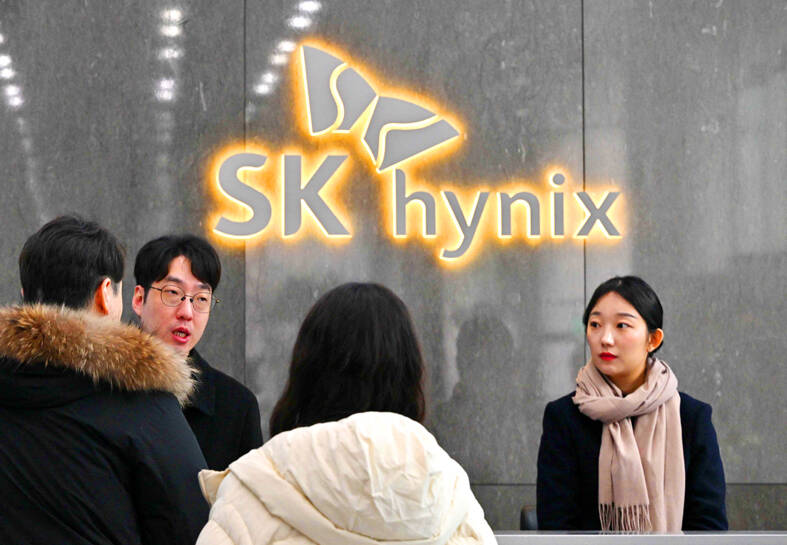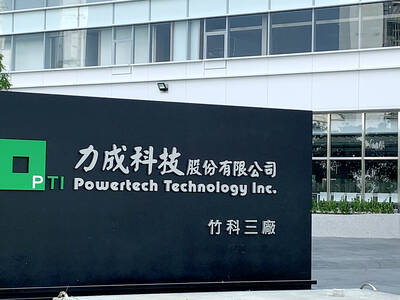SK Hynix Inc plans to spend US$3.87 billion building an advanced packaging plant and research center for artificial intelligence (AI) products in Indiana, marking a win for US President Joe Biden’s administration as it seeks to increase semiconductor output on US soil.
The world’s No. 2 memorychip maker said it would build its first US facility in West Lafayette, with plans to begin mass production in the second half of 2028. The plant will center on a production line for next-generation high-bandwidth memory (HBM) chips, critical components of the graphic processors that train AI systems.
SK Hynix has evolved into a key player in the AI development boom as the leading designer and producer of HBM chips, which work in tandem with Nvidia Corp’s processors.

Photo: AFP
Its decision comes about two years after the company announced plans to invest in the US. At the time, SK Group chairman Chey Tae-won said his conglomerate would set aside about US$15 billion to build chip facilities and bolster research programs in the US.
Wednesday’s announcement is part of that total commitment, the company said.
SK Hynix has also applied for grants from the CHIPS and Science Act, which is aimed at promoting the return of semiconductor manufacturing to the US.
SK Hynix’s project marks a significant step forward for US ambitions to add advanced packaging capacity — a bottleneck in Washington’s efforts to revitalize the domestic semiconductor industry. The US has only 3 percent of the world’s packaging capacity, meaning that firms manufacturing chips in the US often still have to ship them to Asia to be assembled for use.
Semiconductor firms have pledged to invest more than US$230 billion on US soil since Biden took office, spurred by the 2022 chips legislation.
Intel Corp last month won US$8.5 billion in grants and as much as US$11 billion in loans from the US to support more than US$100 billion in investments at home.
The Biden administration also plans to award more than US$6 billion to SK Hynix rival Samsung Electronics Co and more than US$5 billion to Taiwan Semiconductor Manufacturing Co (TSMC, 台積電).
Most of those investments have so far gone to Texas, New York and Arizona. The Grand Canyon state alone has secured more than US$60 billion in investments from TSMC, Intel, Amkor Technology Inc and dozens of others.

US sports leagues rushed to get in on the multi-billion US dollar bonanza of legalized betting, but the arrest of an National Basketball Association (NBA) coach and player in two sprawling US federal investigations show the potential cost of partnering with the gambling industry. Portland Trail Blazers coach Chauncey Billups, a former Detroit Pistons star and an NBA Hall of Famer, was arrested for his alleged role in rigged illegal poker games that prosecutors say were tied to Mafia crime families. Miami Heat guard Terry Rozier was charged with manipulating his play for the benefit of bettors and former NBA player and

The DBS Foundation yesterday announced the launch of two flagship programs, “Silver Motion” and “Happier Caregiver, Healthier Seniors,” in partnership with CCILU Ltd, Hondao Senior Citizens’ Welfare Foundation and the Garden of Hope Foundation to help Taiwan face the challenges of a rapidly aging population. The foundation said it would invest S$4.91 million (US$3.8 million) over three years to foster inclusion and resilience in an aging society. “Aging may bring challenges, but it also brings opportunities. With many Asian markets rapidly becoming super-aged, the DBS Foundation is working with a regional ecosystem of like-minded partners across the private, public and people sectors

BREAKTHROUGH TECH: Powertech expects its fan-out PLP system to become mainstream, saying it can offer three-times greater production throughput Chip packaging service provider Powertech Technology Inc (力成科技) plans to more than double its capital expenditures next year to more than NT$40 billion (US$1.31 billion) as demand for its new panel-level packaging (PLP) technology, primarily used in chips for artificial intelligence (AI) applications, has greatly exceeded what it can supply. A significant portion of the budget, about US$1 billion, would be earmarked for fan-out PLP technology, Powertech told investors yesterday. Its heavy investment in fan-out PLP technology over the past 10 years is expected to bear fruit in 2027 after the technology enters volume production, it said, adding that the tech would

YEAR-END BOOST: The holiday shopping season in the US and Europe, combined with rising demand for AI applications, is expected to drive exports to a new high, the NDC said Taiwan’s business climate monitor improved last month, transitioning from steady growth for the first time in five months, as robust global demand for artificial intelligence (AI) products and new iPhone shipments boosted exports and corporate sales, the National Development Council (NDC) said yesterday. The council uses a five-color system to measure the nation’s economic state, with “green” indicating steady growth, “red” suggesting a boom and “blue” reflecting a recession. “Yellow-red” and “yellow-blue” suggest a transition to a stronger or weaker condition. The total score of the monitor’s composite index rose to 35 points from a revised 31 in August, ending a four-month